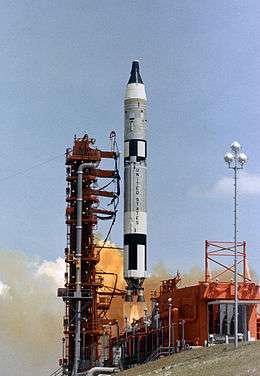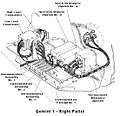Gemini 1
 Launch of Gemini 1 | |||||
| Mission type | Test flight | ||||
|---|---|---|---|---|---|
| Operator | NASA[1] | ||||
| COSPAR ID | 1964-018A | ||||
| SATCAT № | 782 | ||||
| Mission duration | 4 hours 50 minutes | ||||
| Distance travelled | 2,789,864 kilometers (1,733,541 mi) | ||||
| Orbits completed | 63 | ||||
| Spacecraft properties | |||||
| Spacecraft | Gemini SC1 | ||||
| Manufacturer | McDonnell | ||||
| Launch mass |
3,187 kilograms (7,026 lb) 5,170 kilograms (11,400 lb) (with 2nd stage) | ||||
| Start of mission | |||||
| Launch date | April 8, 1964, 16:01:01.69 UTC | ||||
| Rocket | Titan II GLV, s/n 62-12556 | ||||
| Launch site | Cape Kennedy LC-19 | ||||
| End of mission | |||||
| Disposal | Uncontrolled reentry | ||||
| Decay date | April 12, 1964, 15:00:00 UTC | ||||
| Landing site | Middle of South Atlantic Ocean | ||||
| Orbital parameters | |||||
| Reference system | Geocentric | ||||
| Regime | Low Earth orbit | ||||
| Perigee | 155 kilometers (84 nmi) | ||||
| Apogee | 271 kilometers (146 nmi) | ||||
| Inclination | 32.5 degrees | ||||
| Period | 88.76 minutes | ||||
| Epoch | April 10, 1964[2] | ||||
| |||||
Gemini 1 was the first unmanned test flight of the Gemini spacecraft in NASA's Gemini program. Its main objectives were to test the structural integrity of the new spacecraft and modified Titan II launch vehicle. It was also the first test of the new tracking and communication systems for the Gemini program and provided training for the ground support crews for the first manned missions.[3]
The spacecraft stayed attached to the second stage of the rocket. The mission lasted for three orbits while test data were taken, but the spacecraft stayed in orbit for almost 64 orbits until the orbit decayed due to atmospheric drag. The spacecraft was not intended to be recovered; in fact, holes were drilled through its heat shield to ensure it would not survive re-entry.
Spacecraft
Gemini Spacecraft Number 1 was built specifically for an unmanned mission. Crew life support systems were replaced with ballast to approximate the weight of a crewed spacecraft. Four large holes were drilled in the capsule's ablative heat shield to ensure the spacecraft was destroyed during reentry. In place of the crew couches were measuring equipment that relayed telemetry measuring the pressure, vibration, acceleration, temperature, and structural loads during the short flight.
As with any new spacecraft, there were problems at first during system testing, and also the rocket ran into problems, as the Air Force had yet to make the Titan II totally reliable as an intercontinental ballistic missile, let alone as a manned launch vehicle. One example was a short circuit discovered in the second stage, due to a wire's insulation being cut by a defective clamp. Several more were found with the same problem, meaning that 1,500 clamps had to be replaced. After several months of testing, the launch vehicle and spacecraft were finally ready for launch.
Mission highlights
The first stage was jettisoned after two and a half minutes with the rocket 64 kilometers high and 91 kilometers downrange. At that moment there was an unexpected three second loss of signal from the craft. It was later determined that this brief communications blackout was caused by charged ions from the separation and startup of the second stage, similar to the blackout during spacecraft reentry. All subsequent Gemini flights would have the same brief blackout.[4]
The spacecraft achieved orbit five and a half minutes after launch. The only problem found was that the launch vehicle had provided a bit too much speed and put the spacecraft into an orbit with an apogee of 320 kilometers (170 nmi) instead of the planned 299 kilometers (161 nmi).
Four hours and 50 minutes later, after three orbits, the mission was completed. There were no plans to separate the Titan II second stage, so the retrorockets could not be fired. But this was not necessary, as the high drag caused by the attached rocket stage, plus the low 160-kilometer (86 nmi) perigee, would cause the spacecraft to reenter by itself after an expected three and a half days. However, the slightly higher than planned orbit caused it to stay up for almost four days. It was tracked by the Manned Space Flight Network until it reentered over the South Atlantic, midway between South America and Africa. The Gemini 1 mission was supported by the following U.S. Department of Defense resources: 5,176 personnel, 11 aircraft and three ships.[5]
Instrument pallets
 Gemini 1 Instrument Pallets (NASA)
Gemini 1 Instrument Pallets (NASA) Gemini 1 Right Pallet (NASA)
Gemini 1 Right Pallet (NASA) Gemini 1 Left Pallet (NASA)
Gemini 1 Left Pallet (NASA)
References
![]() This article incorporates public domain material from websites or documents of the National Aeronautics and Space Administration.
This article incorporates public domain material from websites or documents of the National Aeronautics and Space Administration.
- ↑ Hacker, Barton C.; Grimwood, James M. (February 2003) [First published 1977]. "Table of Contents". On the Shoulders of Titans: A History of Project Gemini. NASA History Division, Office of Policy and Plans. NASA History Series. Washington, D.C.: NASA. NASA SP-4203. Retrieved 12 September 2013.
- ↑ McDowell, Jonathan. "SATCAT". Jonathan's Space Pages. Retrieved March 23, 2014.
- ↑ "Gunters Space Page". Retrieved 15 October 2012.
- ↑ Chris Kraft, Flight, p. 203.
- ↑ On The Shoulders of Titans - Appendix G-2
External links
| Wikimedia Commons has media related to Gemini 1. |

